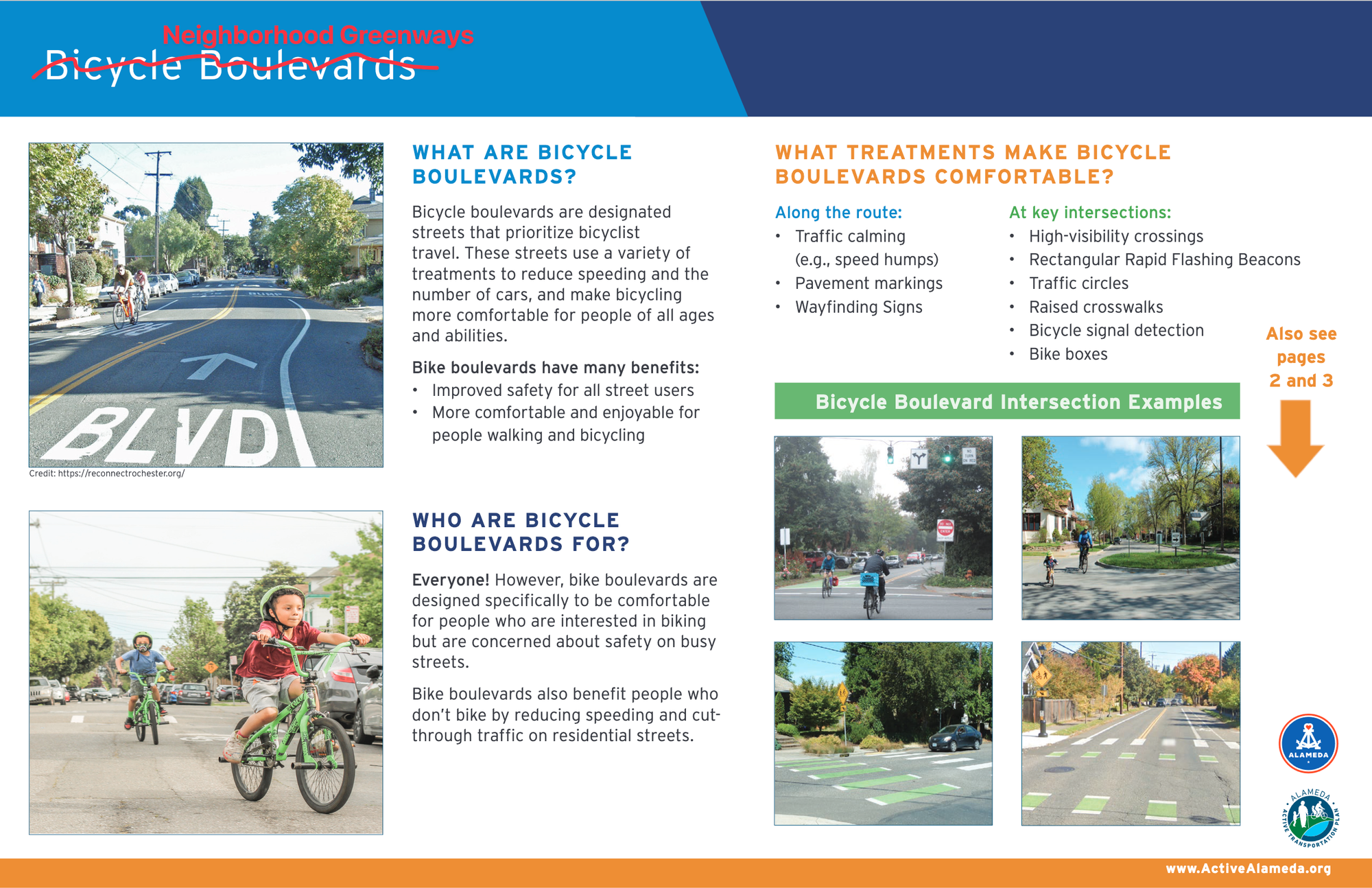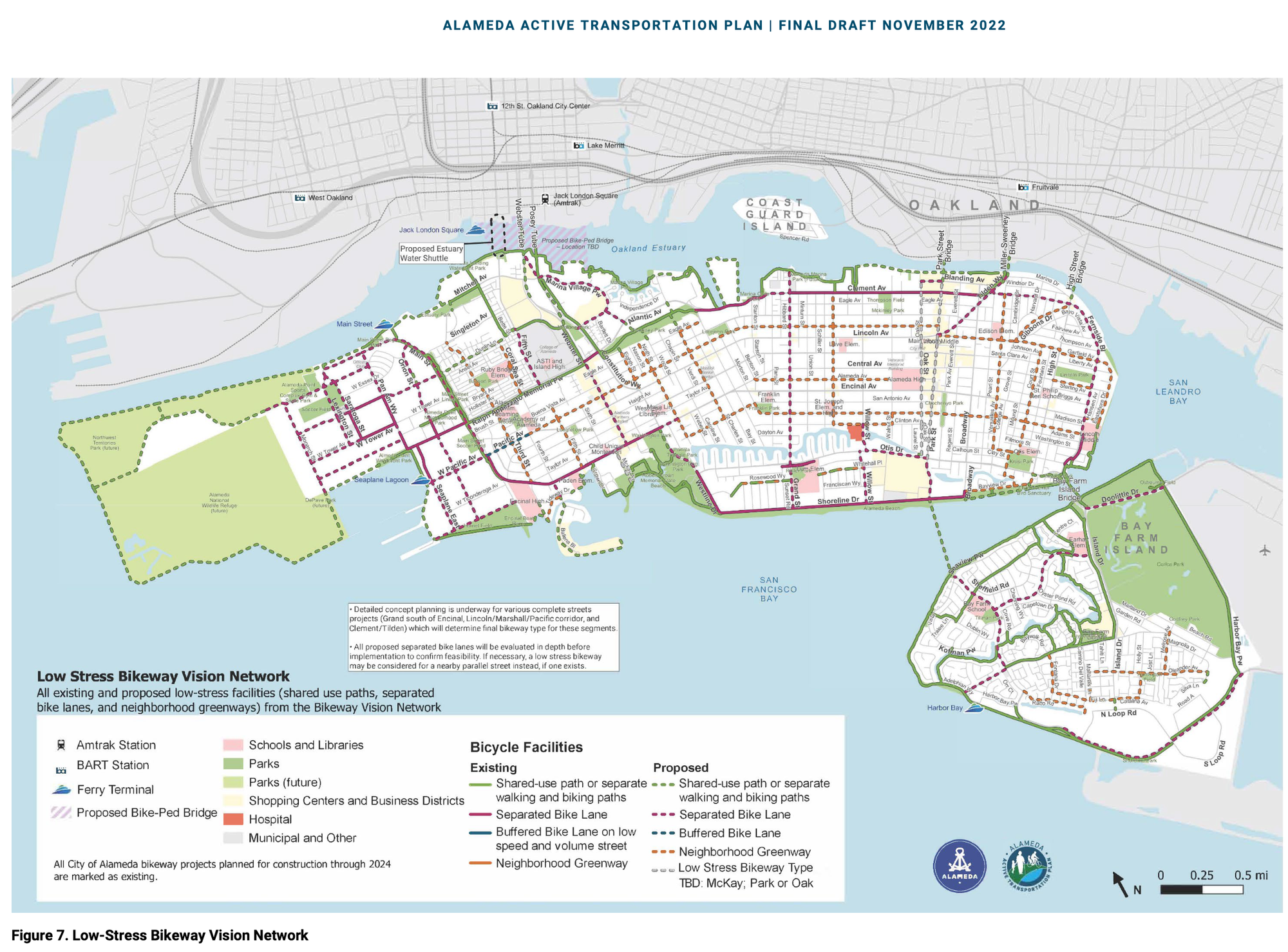It brings me no pleasure to write that the City of Alameda is fumbling its program to build a network of residential streets that are comfortable for kids, seniors, and people of all abilities to bicycle and walk across Alameda.
Instead of allocating additional capital budget, instead of allocating additional staff headcount, instead of allocating additional dollars for consultants, the City Council listened at tonight's budget workshop to an update from the City Manager that staff are thinking about taking down the "A-frame" barricades marking the remaining Slow Streets.
What would replace the barricades? More on what the city's adopted plans say in a minute. But as far as what the City Manager and city staff said last night: Nothing would replace most of the barricades.
The Slow Streets program wouldn't be physically present anymore. The program to make the remaining Slow Streets permanent and to add some connecting residential streets to form a network of "Neighborhood Greenways" across all of Alameda Island and Bay Farm — with more appropriate physical designs along the length of the roads — would happen sometime... sometime by the year 2030.
To make that happen, city staff don't want any more staff or any more money at this point — even though multiple City Councilmembers asked if they needed more and the city currently has $29 million additional funds available.
The only thing that the City Manager and city staff spoke to increasing: public outreach.
And on this, councilmembers could only agree: More public outreach and a thorough process of community engagement and communication is important before residential streets are physically changed.
Two questions that seemed to me to go unasked:
- Didn't the City of Alameda already conduct a thorough process of public outreach and community engagement for this program?
- Who exactly is the public that needs more public outreach before this program can proceed?
What was the "Active Transportation Plan"?
From 2019 to 2022, city staff and a consulting team developed the Alameda Active Transportation Plan. The plan took so many years to develop, in part, due to a worldwide pandemic — but on the upside, the three distinct phases each involved multiple rounds of broad and deep public engagement through both in-person and remote means, synchronous and asynchronous means. Here are excerpts from the plan timeline:
Phase 1: Discovery Phase (October 2019 – January 2020)
During this period, we heard from residents, business owners, visitors, and employees in Alameda. We did this through an open house attended by 150+ people; an interactive web map that received 2,100+ comments; a statistically significant community survey; and multiple pop-ups and presentations at existing events. We learned not only what works in the walking and biking environment, but more importantly what keeps people from biking or walking in Alameda.
Phase 2: Drafting Recommendations Phase (February – August 2020)
Summary by the numbers:
• 10 public events/meetings + presentations to 4 organizations
• 25,140 emails delivered via 9 different mailing lists
• 8 surveys with 683 total responses
• 550 comments on the bicycle network map
Phase 3: Finalizing the Plan (January - December 2022)
We took the community feedback from 2020, updated the draft recommendations, prioritized the projects and programs and compiled them into a complete Active Transportation Plan. The Public Review Draft Plan was released for public comment on October 3, 2022, and input was received over the month of October. The Final Draft Plan was updated based on this input, and was released on November 9, and presented at the November 16 Transportation Commission meeting where they recommended approval. The City Council adopted the Plan at their December 20, 2022 meeting.
That's a lot of public input — plus a good deal of time for staff and consultants to do multiple rounds of summary and synthesis.
The Neighborhood Greenways program, in particular, did go through multiple rounds of revision during this process. In earlier versions of the Active Transportation Plan, this street type was going to be referred to as "bicycle boulevards" — that's the term that's used to label them on some of the Active Transportation attachments:

Bicycle boulevard is a well-known name used around the country and the region. The country's first bike boulevard was created in Palo Alto (I grew up cycling along it — it was a lovely contrast with the dangerous Santa Clara County expressways I also grew up cycling along).
But I can also see how Alameda's staff and consultants are trying to frame these street improvements as relevant to more than just cyclists. The design features proposed in the Active Transportation Plan for the Neighborhood Greenways would not just be felt by cyclists but also by pedestrians walking along the greenways and nearby residents who would benefit from calmer and more orderly driving by motorists.
Whatever they're called, the Neighborhood Greenways were studied and developed as part of the Active Transportation Plan.
The Neighborhood Greenways are integral components of achieving the Active Transportation Plan's low-stress bikeway vision network. Look at the orange-ish dashed lines and trace with your finger to many of the important destinations that will be reachable by a kid on a bike — but only if the Neighborhood Greenways are all built:

What was "The Future of Slow Streets"?
The Alameda Active Transportation Plan website also has a page titled "The Future of Slow Streets" — it's an easy read and I recommend skimming it — here's the beginning:
In early 2020, Alameda along with many cities around the nation, implemented “Slow Streets,” a new type of facility that facilitated physical distancing during the COVID-19 pandemic. Over a 1.5-year period, 4.7 miles of Alameda streets became Slow Streets. This program was extensively evaluated in fall 2021. Much more information can be found on the Slow Streets web page.
In December 2021, the City Council considered the Slow Streets evaluation and staff recommendations, and voted to continue the Slow Streets program until the Active Transportation Plan provided direction on the future of the program AND these actions were implemented.
That last sentence is why the "A-frame" barricades have remained in place so long — because City Council voted to retain them until the actions of the Active Transportation Plan were implemented — one would assume the action of building the Neighborhood Greenways.
The "A-frames" barricades aren't that functionality useful for most of their locations at this point. But they have served as a physical reminder of what's planned for those places — as a placeholder for what many people have asked for and what the city has proposed to install next.
Who is "the public"?
Given all of the public outreach, the listening, and the synthesis conducted as part of that three-year planning process, I find it difficult to understand why at last night's City Council meeting the City Manager and city staff and a couple councilmembers were proposing to start a robust public engagement and communication process for the Neighborhood Greenways... when one had already been started and conducted across the entire city.
The Active Transportation Plan is still relevant, it's still fresh, it's only 18 months old. Many plans are actively consulted and followed for years if not decades. (Until quite recently, I believe the City of Alameda was still using its General Plan from 1990 — the cover showed a map of the mythical "Southern Crossing" bridge from Alameda to the Peninsula.)
But I do actually think I understand the concern: It's not about public engagement in terms of engaging a broad sample of Alameda residents, visitors, employees, and everyone else who travels through Alameda — how the Active Transportation Plan engaged the public. The concerns expressed at tonight's meeting were that the city has to engage with the private attachment that residents may feel toward the public street in front of their home.
What was implied is that the City of Alameda has to get tacit permission from residents fronting a public right-of-way before making physical improvements to the street design to benefit the broader public of pedestrians and cyclists who use that public street. Or the City of Alameda has to communicate so pro-actively and so thoroughly with residents fronting a public right-of-way that those residents can drive the entire project schedule... or may come to hold an effective veto over it.
What was also said — explicitly by the City Manager — is that this need for engagement and communication makes the overall ordering of a Neighborhood Greenway project complex: how do you get the residents of a street to give input before a design concept is ready? but how do you prepare the design concept before you get input from the residents of the street?
One way to solve this dilemma is to do nothing — and I assume that's why there's been little word out of City Hall about the Neighborhood Greenways program in a while.
What's been lacking?
This lack of clarity is one of the reasons why I've been arguing so strongly for the city to make available both more staff positions and more budget to get transportation projects in residential neighborhoods back on track — because it hasn't been clear from the outside what specific capacity is missing and should be supplemented.
So, there's no timeline for when to discuss extending the four new blocks of bike lanes on Webster Street up to Ralph Appezzato Memorial Parkway and the Cross Alameda Trail.
I don't want to over-complicate this blog post by talking too much about non-residential corridors or make it sound like I'm wishing for cycling improvements to be made to every single street in the city. But what's at stake here is having a cycling network that is comfortable enough and comprehensive enough to be used by all — including everyone on the West End.
Is this timeline constrained by staff resources? Is it a strategic choice? Who knows. It wasn't discussed at this Council meeting. In any case, I'll just share this non-update about Webster Street and focus on Neighborhood Greenways to conclude this blog post...
The capacities we need more of going forward
So at least it's now clarifying to hear how the City Manager and department directors presented the Neighborhood Greenways program to City Council at this budget workshop. I say this with all due respect to experienced professionals who are doing complicated jobs with many tradeoffs and also with all due respect to our elected leaders who are entitled to their own visions of how to be responsive to their constituents: It's now more clear what capacities the City of Alameda is lacking at this moment — it's more clear why residential streets are not getting traffic safety improvements and why a city-wide low-stress cycling network is still just penciled in for 2030 and slipping.
If Alameda is going to make it safe for students to be able to bicycle to all elementary and middle schools in the city; if Alameda is going to reduce to zero the number of seniors who are killed or seriously injured while on foot or bike each year; if Alameda is going to enable owning a car to be a personal choice rather than a necessity within this town; if Alameda is going to achieve its carbon goals and do our part to stave off a more dangerous climatic future, then it's not just staffing resources and budgetary resources that we need, but also two more capacities:
- Commitment to plans when those plans been crafted with broad input — true city-wide public input.
- And courage to implement improvements to publicly-owned streets to benefit all who travel throughout this city.
I wish the city the best of luck with the one Neighborhood Greenway that staff said at tonight's City Council meeting they will be hiring a consultant to start planning later this year.